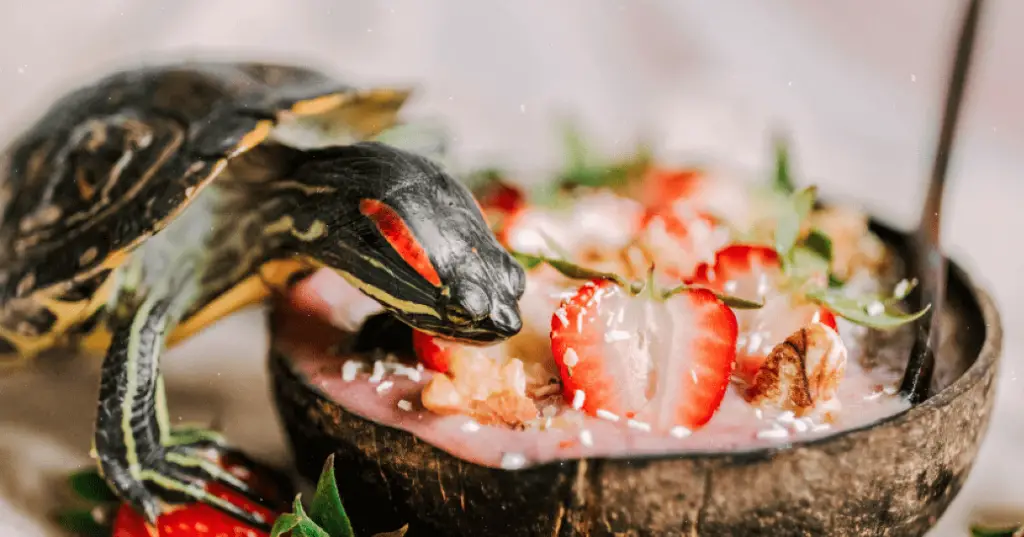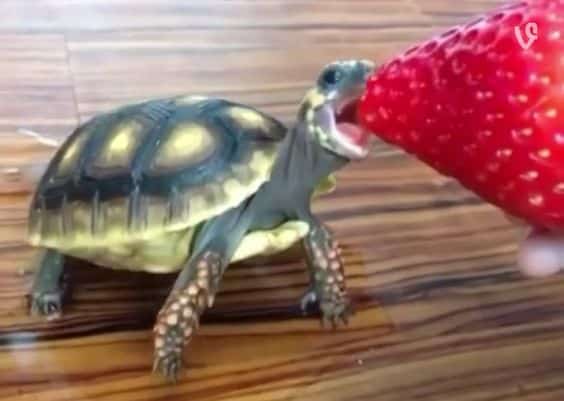Sliders, like all reptiles inhabiting cold climates, go into brumation – a low-energy quasi-sleep like hibernation – during the winter. so there is no surprise if you are questioning your self “Why won’t my Red-Eared Slider Turtle eat?” This is not a critically dangerous event, but the turtle’s metabolism slows down and they don’t eat for months on end. So if your red-eared slider has not been eating for a while, do not panic. If it still seems active enough (you can see its eyes moving), keep offering food regularly. Stop only when the temperature drops below 10 °C, so the turtle feels cold and does not try to feed it when it has gone into brumation.
Other Possible Reasons for a Turtle’s Lack of Appetite
There could be many reasons for your red-eared slider turtle’s lack of appetite. Some reasons may be simple to address, such as changing its diet. However, there are also some possible serious medical conditions that could result in your turtle’s lack of appetite.
In order to help your red-eared slider recover from her loss of appetite and find a solution for it, you should first understand the factors that could influence her behavior.
Stress
One of the most common reasons for a turtle’s lack of appetite is stress. Red-eared slider turtles get stressed when they feel threatened, such as in an aquarium with other turtles and tank mates that might be too large or aggressive. Your red-eared slider may also feel stressed if you hold her out of the water for too long.
Temperature
Another common reason turtles lose their appetite is a drop in temperature. If your turtle’s enclosure is cold, her metabolism may slow down. In turn, she will experience a loss of appetite and may even stop eating altogether. So rather than questioning why Red-Eared Slider Turtle won’t eat, Try to maintain your red-eared slider’s area between 78 and 80 degrees Fahrenheit.
You can also try to increase the temperature in your turtle’s habitat, though be careful not to overheat the tank and cause your turtle to suffer from heatstroke. You can tell if your red-eared slider is overheated when she breathes with her mouth open and will refuse to swim in her water.
Appropriate Lighting
It’s also important to make sure your red-eared slider has the right lighting. Most turtles need UVA and UVB light, which help them metabolize calcium. You can purchase special bulbs that produce these lights or even use some household items, such as a regular incandescent bulb with paper that filters out most of the light or a compact fluorescent bulb that produces low levels of UV light.
Illness
If your turtle has a parasite or bacterial infection, she may lose her appetite. In fact, even if your turtle has a sick tank mate, she may get stressed and lose her appetite. If you notice any of these symptoms in your red-eared slider, take her to the veterinarian immediately. It’s common for red-eared slider turtles to have vitamin deficiencies that cause disturbances in their usual eating patterns and daily functions. The lack of appetite may be a sign of vitamin deficiency that can be fulfilled through a proper diet.
Diet

Sometimes, loss of appetite can be due to a problem with your turtle’s diet. If your turtle’s diet does not provide all of the nutrients he needs to stay healthy, he will lose his appetite. Try changing up her food and offering her more calcium.

Use Water
If your turtle’s environment is too dry, she may stop eating. Make sure you keep the substrate in her habitat moist and offer her a shallow bowl of fresh water at least twice a day for soaking. You can also spray down the tank once or twice each week to maintain high humidity levels.
Don’t Forget the Calcium!
Most turtles need calcium each day as part of their diet. While your turtle may find pieces of cuttlebone in her enclosure, she still needs a source of calcium outside of her food too. You can purchase special blocks made from cuttlebone, or you can use a calcium powder.
You can also try to sprinkle some calcium on your red-eared slider’s food. Calcium should be sprinkled in your turtle’s water as well, but never add more than one teaspoon of powder per gallon of water.
Be sure that the calcium and vitamin supplements you purchase for your turtle are made for reptiles. If your turtle doesn’t eat her regular food, try using different types of food that might entice her appetite.
Red-eared slider turtles don’t just come out at night to hunt their prey; they need time during the day too. Feed your red-eared slider in the morning and again in the evening.
In the wild, red-eared sliders catch most of their prey at night or dawn and dusk, when it is more difficult for the prey to see them coming. Since your turtle isn’t going to want to eat in a bright room full of noisy people, try feeding her during the day when she’s usually most active. You can try to feed her again at night, but you should turn off the lights if possible to keep things quiet.
Time of Day
While there isn’t much you can do about the time of day your turtle eats, you may need to adjust your schedule for feeding her. It’s important that she eats every single day; even on the weekends!
Time of Year
Red-eared sliders are cold blooded, meaning they need a source of heat to function. During the cooler months, your turtle’s metabolism may slow down and she will not feel as hungry. In turn, she will also seek shelter more often than usual and sometimes will even go into hibernation. If your red-eared slider is sleeping a lot and not eating, take her to the vet.
Time for the Veterinarian
If you follow all these tips and your turtle still refuses food, it’s time to take her to the vet. The veterinarian will be able to diagnose any illnesses or diseases that might be causing your turtle’s appetite to decrease. You should also get your turtle checked out if she hasn’t eaten for three to five days, but keep in mind that some turtles can go up to two weeks without food.
What do I do if my red-eared slider won’t eat?
It is very common for a turtle to refuse to eat, but do not panic. There are several things that you can do to help encourage your pet turtle to eat and once they start eating again; feeding them will be much easier.
Provide the Right Amount of Food
The first thing to do is to make sure that your turtle is getting the right amount of food. How often you need to feed your turtle will depend on your type of turtle and what it eats, but in general once or twice a week should be sufficient. If you are feeding your red-eared slider turtles commercial turtle pellets, you should try increasing the amount that they are fed, to about every two days. It is also a good idea to soak commercial pellets in water before feeding them to your red-eared slider turtles.
Ensure that your Turtle’s Digestive System is Regular
Make sure that your turtle does not have too much waste in its system. In order to do this, you should only feed your turtle enough to last it for a couple of days. Then take out any uneaten food from the tank and clean out their litter box or pan. How often you need to clean the litter box will again depend on what type of turtle you have and how large an enclosure they have, but in general, you should clean it out at least once a week. How to feed your turtle if it is refusing to eat doesn’t have to be difficult, but there are things that you need to know in order to help them get the nutrition that they need.
Check the Temperature
Make sure that the water is at a comfortable temperature for your turtle. Turtles are cold-blooded animals. In other words, they do not produce any body heat, which is why they depend on the surrounding temperature to keep the body warm. If the water temperature is not high enough, turtles will not be able to digest their food properly and may get sick, so stop eating. The exact water temperature depends on the species but is usually 75-80 degrees Fahrenheit (24-27 degrees Celsius). If you keep the water temperature between 75 and 80 degrees, the turtle will start eating again soon.
Try Introducing New Food
Try introducing new food to your turtle if he is only eating one type of food and not many different types. How you introduce new foods will depend on what kind of turtle that you have, but as a general rule it should be done slowly and carefully. You should introduce just one new type of food at a time and give your red-eared slider turtle the opportunity to get used to eating it.
For example, for five days you can feed your turtle its usual food mixed with a small amount of the new food. On the sixth day, you should feed them only the new food and give them another couple of days to get used to it. How long your turtle takes to learn to eat a new type of food will depend on the type of turtle that you have and its natural instincts, but as a general rule, most turtles will not take longer than two weeks.
Don’t Get Stressed
Try not to get too stressed out about your turtle refusing to eat. How you react can make a big difference in whether or not your red-eared slider turtles will start eating again.
Contact a Good Veterinarian
If after following these steps your red-eared slider turtles are still refusing to eat, you should contact a good Veterinarian immediately and get proper medical advice.
How long can a red ear turtle go without eating?
Turtles do not have to eat every day. How often they need to eat depends on how big they are, what kind of turtle they are, and how active the turtle is – the more active their lifestyle is, the more often they will need to eat. Your turtle can go without food for a certain period of time depending on how old it is. How much a turtle eats when it is younger will determine how long it can go without food because as they get older, they become more active and don’t need to eat as often.
How Long Does it Take for a Red-Eared Slider to Starve?
The red-eared slider is generally able to survive for about 160 days without food, assuming that he has access to water and light.
What is the Lifespan of a Red-Eared Slider?
Realistically, red-eared sliders can live for between 20 and 30 years. Although red-eared slider turtles are long-lived, this does not mean they are indestructible – it is important to look after red-eared slider turtles correctly to ensure that they have the best possible chance of living at least 20 years.
About The Author









